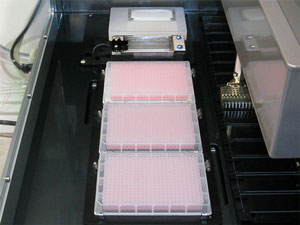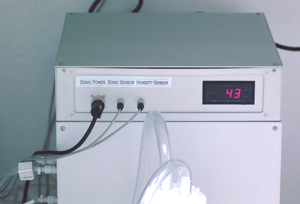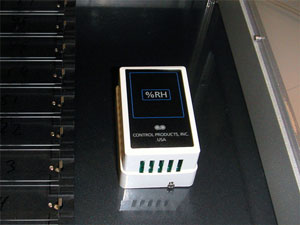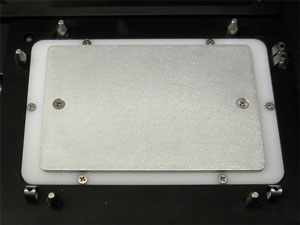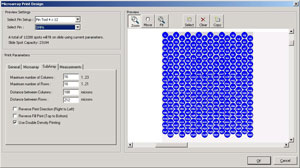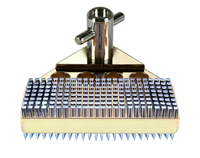NanoPrint™ 2 LM60PRO-2 and NanoPrint™ 2 LM210PRO-2 Enterprise Level Protein Edition Microarray Printers
Data Sheet
![]() Shop this product in our online store
Shop this product in our online store
Products - Microarrayers - NanoPrint™ 2 LM60PRO-2 and NanoPrint™ 2 LM210PRO-2 Enterprise Level Protein Edition Microarray Printers
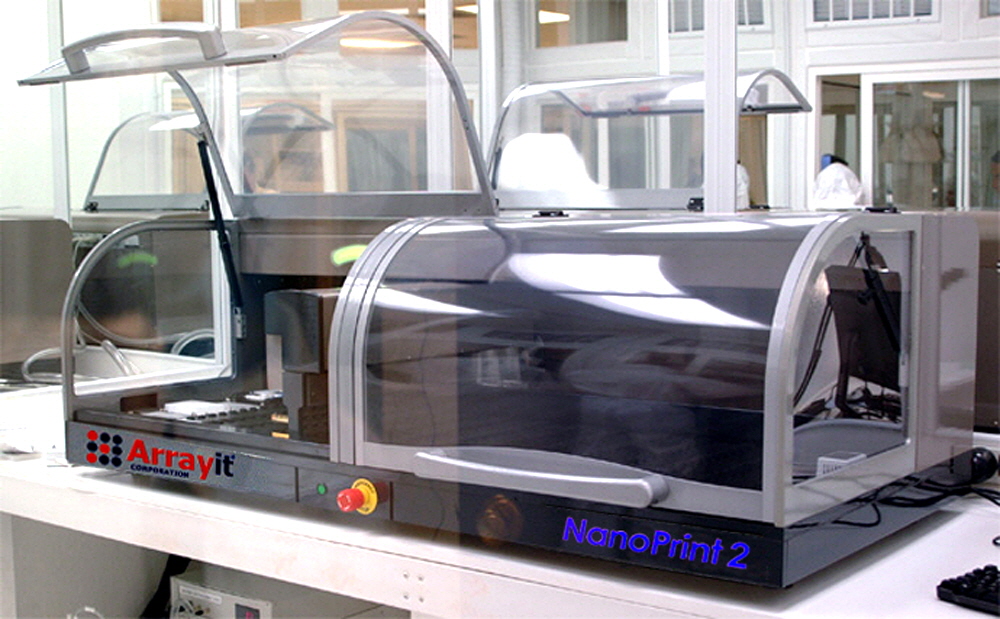
New!! NanoPrint™ 2 Protein Edition Microarray Printers build on the enterprise level linear drive systems that have provided the market’s most advanced universal platforms for protein microarray manufacturing for more than a decade. Based on advanced nanotechnology with version 2 motors, controllers and Ethernet connectivity, Arrayit NanoPrint™ 2 LM60PRO-2 and LM210PRO-2 robots offer 500 nanometer resolution and sub-nanoliter protein sample dispense volumes using Arrayit patented high-throughput contact printing technology installed in 4,200+ laboratories worldwide. Nano 2 instruments set a new standard for high-speed protein microarray manufacturing in research, diagnostics and pharmaceutical settings.
NanoPrint™ Protein microarrayers videos, click here.
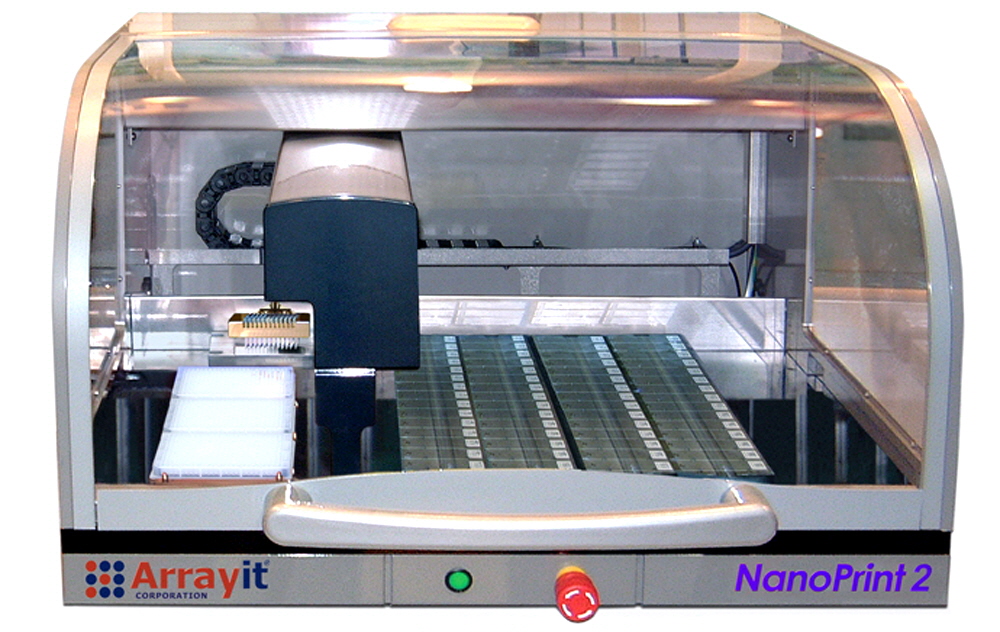
Figure 1. Shown is the NanoPrint™ 2 Protein LM60 system with a capacity of three 384-well sample microplates with plate cooling printing onto 60 standard glass substrates.
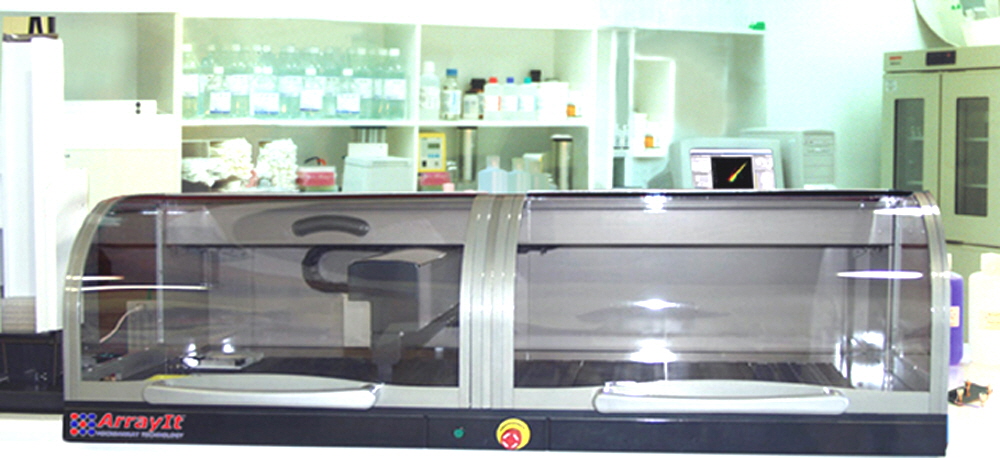
Figure 2. Shown is the NanoPrint™ Protein LM210 system with a capacity of three 384-well sample microplates printing onto 210 standard glass substrates.
 NanoPrint™ Protein Microarrayers are industrial-level platforms for all microarray manufacturing applications including DNA microarrays, protein microarrays, and other types of biomolecules. NanoPrint™ Protein systems enable the manufacture of microarrays utilizing ArrayIt® 192, Professional, 946 and Stealth Style Micro Spotting Pins. The NanoPrint™ Protein uses superior linear drive motion control technology and proprietary Warp1 controllers, and is compatible with all standard microarray surfaces made by ArrayIt® and other glass substrate slide open platform vendors. Systems are easily configured to print onto different types of surfaces including 96-well plates, plate-sized glass, and proprietary cartridges and cassettes by taking advantage of flexible and modular deck configurations and an easy to use software interface. The Microarray Manager Software combines unparalleled power and simplicity in a graphical user interface. Click here for a NanoPrint™ Protein Microarray Manager Software tutorial.
NanoPrint™ Protein Microarrayers are industrial-level platforms for all microarray manufacturing applications including DNA microarrays, protein microarrays, and other types of biomolecules. NanoPrint™ Protein systems enable the manufacture of microarrays utilizing ArrayIt® 192, Professional, 946 and Stealth Style Micro Spotting Pins. The NanoPrint™ Protein uses superior linear drive motion control technology and proprietary Warp1 controllers, and is compatible with all standard microarray surfaces made by ArrayIt® and other glass substrate slide open platform vendors. Systems are easily configured to print onto different types of surfaces including 96-well plates, plate-sized glass, and proprietary cartridges and cassettes by taking advantage of flexible and modular deck configurations and an easy to use software interface. The Microarray Manager Software combines unparalleled power and simplicity in a graphical user interface. Click here for a NanoPrint™ Protein Microarray Manager Software tutorial.
Rationale for the NanoPrint™ Protein
A starter pack of consumables to get you started printing your sensitive samples immediately includes Microarray Microplates, SuperEpoxy Substrates, SuperProtein Substrates, Protein Printing Buffer, and BlockIt Blocking Buffer.
- Proteins have a number of levels of organization. This includes the primary structure, (amino acid sequence, held together by covalent bonding), the secondary structure (structures such as the beta-pleated sheets and that are held together primarily by hydrogen bonding), the tertiary structure (held together by hydrogen bonding and disulfide bonds) and the quaternary structure (which combines multiple amino acid sequences together by hydrogen, disulfide and other bonding).
- Each one of these levels of organization is required for an active protein and required to print high quality protein microarrays that can detect protein interactions. In addition, intact epitope structure is a requirement for antibody binding.
- Hydrogen bonding, the force that maintains the correct folding of proteins, has temperature-dependant labiality. This temperature-dependant change in structure results in protein denaturation and inactivation and destruction of proteins. For every 10 degrees Celsius, the rate of denaturation doubles.
- The optimal temperature for proteins in the liquid phase is 4ºC. For the last 50 years, protein biochemistry has been performed in the cold room. The Protein Edition NanoPrint™ reduces or eliminates the requirement to work in the cold while maintaining protein structure.
- Another key factor that affects protein integrity is microbial contamination (bacteria and fungi). The metabolic rate of microbes is greatly reduced in the cold, which reduces microbial doubling time and sample degradation.
Software features include:
- A Method Creation Wizard
- User & version control management
- Custom calibration of the slide and microplate positions
- Complete sample tracking
- Support of input and output data files
- Custom microarray designs
- Customizable speed profiles and wash protocols
- Automatic Method Validation
- Runtime sample and spotting views as well as a Simulation Mode
- Easy to use graphical Re-Print Wizard
The high speed, high precision linear servo control system of the NanoPrint™ Protein produces superior instrument performance that is essentially free of friction, noise and thermal emission. Combined with the compact bench top design, user configurable worktable, humidity and particulate control, a host of available options, and the flexible and sophisticated software, NanoPrint™ Protein systems offer the complete solution to high performance microarray printing.
NanoPrint Protein Options:
- 48 or 192 Maximum Pin Configurations
- Anti-vibration table
- Peltier-driven microplate cooling
- Microplate printing worktables
- Custom worktables for proprietary printing cassettes and cartridges
- Worktable conveyor
- Microplate stackers with lid removal and barcode reader
- Dehumidification
- Extended service warranty
The value of the linear servo motor technology used on NanoPrint™ 2 Protein Microarrayers:
- Nanometer scale positional accuracy
- Quiet operation
- No vibration
- No heat generation
- No motor dust
- Superior Accuracy
- Near maintenance-free operation
- High speed
- High load capacity
- Zero "sagging" with loss of power
- Safer and much more durable than stepper motors
Specifications
Software |
|
Interface |
Intuitive and Graphic Windows 10 User Interface |
User Management |
Password protected access levels for User, Manager and Administrator |
Data Files |
Both import and export of data files compatible with all current microarray detection instruments |
Version Control |
Complete tracking of all methods, version and backups |
Automatic Method Validation |
Automatically validates for compatible method parameters |
Sample and printing Views |
Each available in real-time during operation |
Method Creation Wizard |
Only minimal information required to create microarray printing protocols |
Simulation Mode |
Pre-test print methods in software prior to running programs |
Flexible |
Microarray design, pin configuration, worktable layout, source and destination type, offsets, speed profiles, wash/dry parameters and pre-print locations |
Hardware |
|
Size (L x W x H, cm) |
LM60PRO-2 (110 x 85 x 56 cm), LM210PRO-2 (164 x 85 x 56 cm) |
Weight (kilograms) |
LM60PRO-2 (150 kg), LM210PRO-2 (200 kg) |
Positional resolution |
500 nanometers using linear drive Warp2 control |
Printing speed |
96 spots per second |
Destination |
Microarray substrates, glass slides, microplates, custom |
Printing technology |
Arrayit Pro, 946 or Stealth pins and printheads |
Number of pins |
Configurable 1 to 48 |
Spot diameter |
37.5 microns or larger to meet all applications |
Minimum spot spacing |
50 microns |
Pre-printing |
User definable |
Wash/Dry station |
Ultrasonic with 2 wash positions and a dry station |
Number of microplates |
Three standard 384-well, customizable |
Number of substrates |
60 substrate slides (LM60PRO-2) or 210 substrate slides (LM210PRO-2) |
Number of microplates |
15 96-well microplates (LM60PRO-2) or 45 96-well microplates (LM210PRO-2) |
Microplate type |
96-well or 384-well microplates |
Microplate cooling |
Cool 1-3 microplates, for protein microarray applications |
Environmental control |
Fully enclosed, HEPA filtration and user-defined humidity control |
NanoPrint™ 2 Protein Flexible Deck Configurations: |
|
|
Accessory Control Module (ACM): |
|
|
NanoPrint™ 2 Protein Pin Cleaning Module: |
|
|
NanoPrint™ 2 Protein ACM Connectivity: |
|
|
NanoPrint™ 2 Protein Humidity Sensing: |
|
|
NanoPrint™ 2 Protein Microplate Peltier Cooling: |
|
|
NanoPrint™ 2 Protein Software: |
|
|
48 and 192 Pin Configurations are now available. 192 Pin configuration allows the user to run from 1 to 192 pins at 2.25 mm center to center spacing to pickup samples from 1536 well plates. Standard deliverable is 48 Pins at 4.5mm centers for use with 384 well plates (96 well plates can also be configured). NanoPrint™ 2 software and unique Pin and Printhead design allows the end user to setup the pin tool any way that they like. Multiplex array processing systems, plates, biochips micro fluidics, and cartridges can all be easily configured. |
|
|
Superior Z-Axis Resolution for Optimum Spot Morphology: |
|
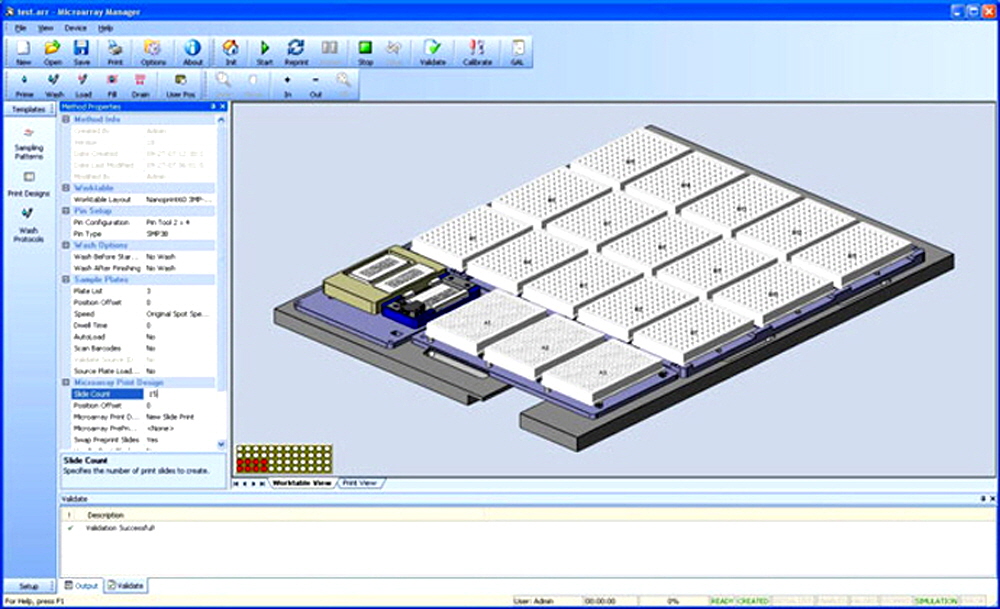
Figure 3. The NanoPrint™ 2 Protein deck is configured in a module manner, allowing different worktables to be inserted and removed from the deck for different printing applications such as glass substrates, microplates, and proprietary cassettes and cartridges. The screenshot shows a worktable allowing printing into 15 microplates (96-well) for the NanoPrint™ Protein LM60-2.
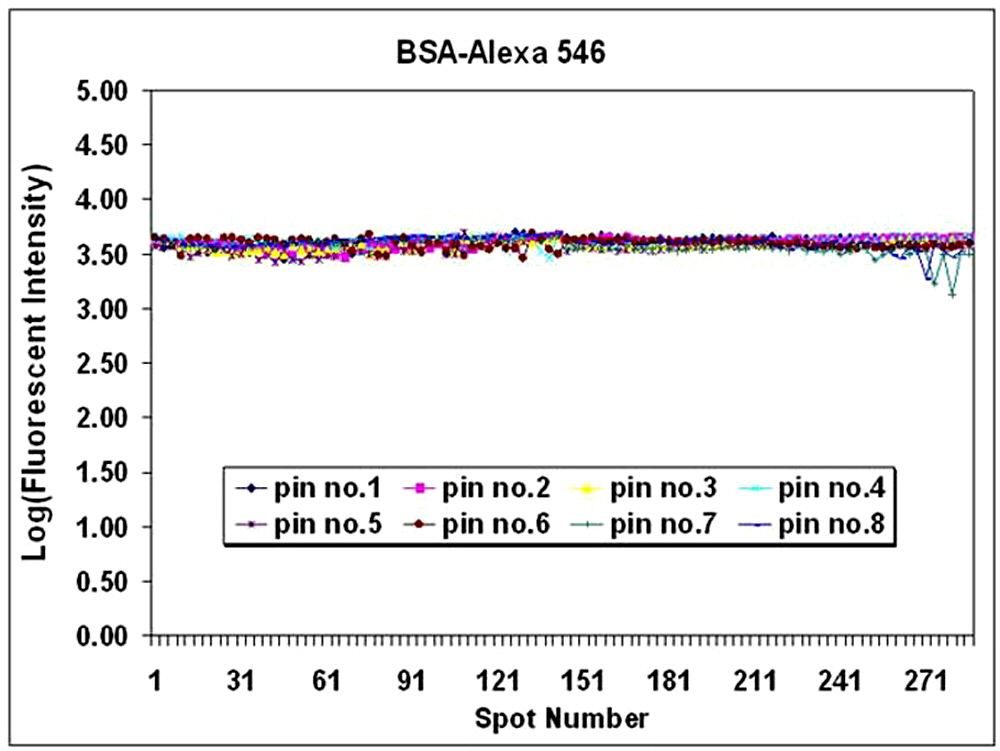
Figure 4. Data showing the printing consistency of eight different SMP3B pins in a single print run using the NanoPrint Protein LM60. The data were provided courtesy of W.G. Shreffler and L. Bardina at the Mount Sinai School of Medicine (New York, USA).
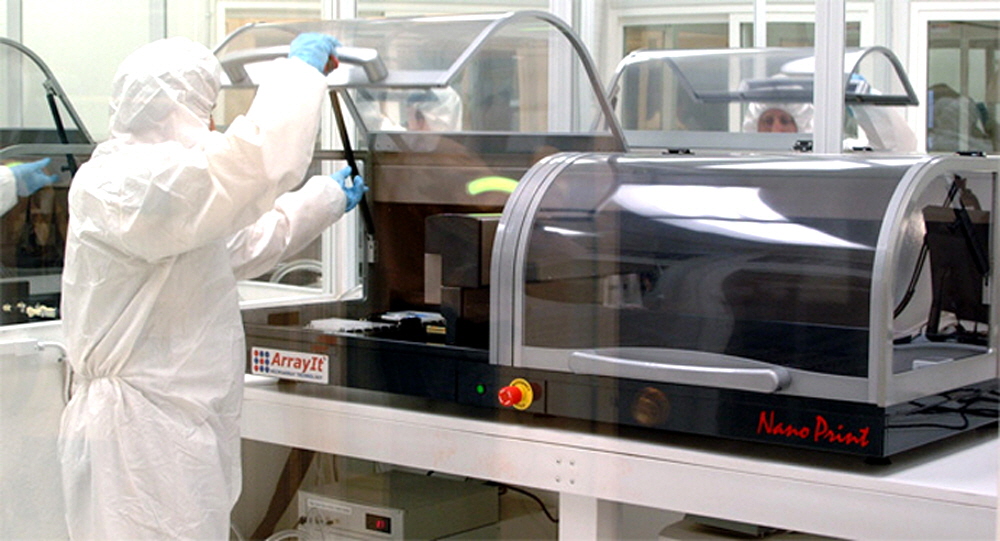
Figure 5. Shown is the NanoPrint™ Protein LM210 system configured in an ArrayIt® class 1 cleanroom. The entire deck is accessible via two doors that open and close independently for user convenience and safety. The top of the Accessory Control Module (ACM) is shown beneath the robot. Microarray manufacturing parameters including the number of pins, substrates, spots, technical replicates, printing pattern, worktable, printing offsets, speed, acceleration, and many other technical aspects are completely controllable by the operator via an intuitive graphical user interface (GUI). The NanoPrint™ Protein MicroarrayManager Software allows users to write completely customized printing routines in minutes. Worktables allow the user to switch between glass substrate slides and microplates using different worktables and software routines.
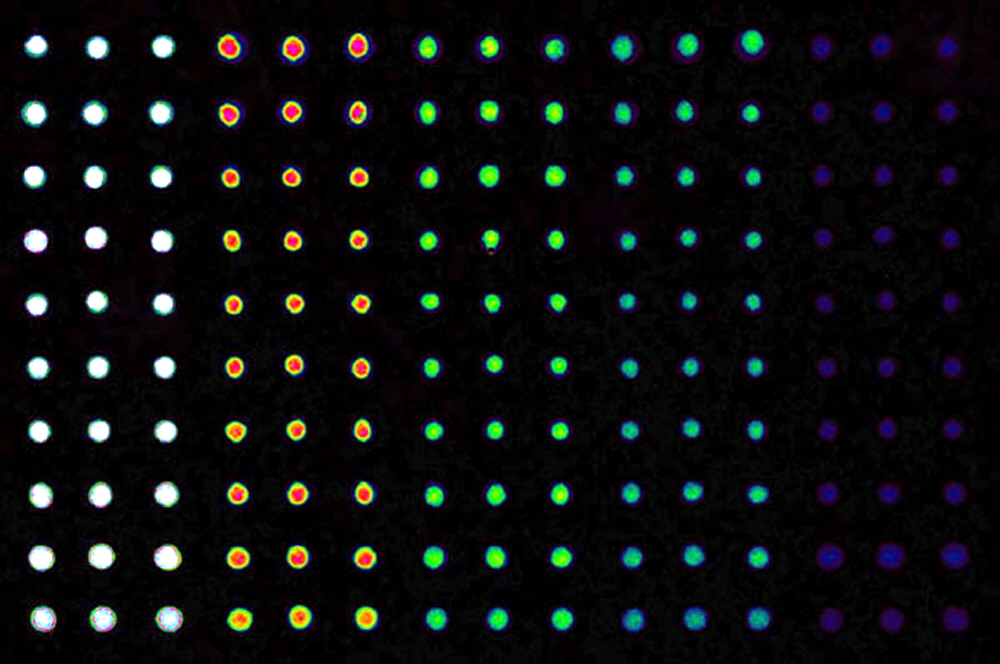
Figure 6. IgG Diltuion Series manufactured with the NanoPrint Microarrayer and other key components of the Arrayit ImmunoPlex Platform. 16-bit raw data visualization in rainbow color pallet showing detection down to a printed concentration of IgG at 0.0001 microgram per microliter of IgG. Spot size is 200 microns at 400 micron center to center spacing.

Figure 7. Shown is the NanoPrint™ 2 Protein 48-pin printhead designed to hold up to 48 microarray printing pins of the Professional, 946 or Stealth series. The attachment bayonet allows the printhead to be attached and removed for cleaning easily and precisely, eliminating the need for system re-calibration. System can also be configure to run 192 Style Pins and Printheads.

Figure 8. Shown is the point of a Professional Series 3 (Pro3) microarray printing pin. Samples load into the pin uptake channel by capillary action, and direct contact between the sample layer on the pin tip and the glass printing substrate results in the formation of a printed microarray spot. The NanoPrint™ Protein LM60PRO-2 and LM210PRO-2 systems control pin movements in 500 nanometer increments for unsurpassed printing precision at speeds of 48 spots per second. A total of 48 microarray printing pins of any tip size from the professional, 946 or Stealth series may be used on our NanoPrint™ 2 Protein systems.
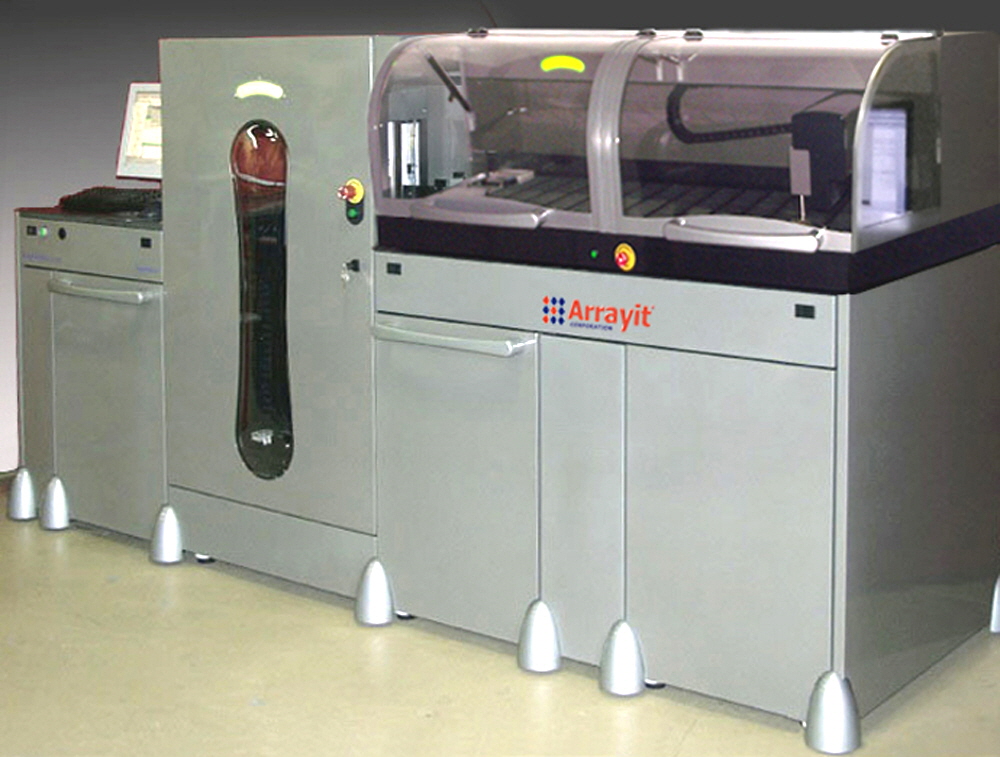
Figure 9. Shown is the Worktable Workstation for the NanoPrint™ 2 Protein LM60PRO-2 and LM210PRO-2 systems. The Worktable Workstation allows fully automated conveyor-based loading and unloading of glass slide substrate, microplate, and custom worktables from the NanoPrint™ 2 Protein deck. With a capacity of 60 worktables, the WorkTable Workstation allows fully automated printing onto 1800 glass substrates, 300 96-well microplates, or 900 custom cassettes. The Worktable Workstation integrates directly into both the LM60PRO-2 and LM210PRO without the need for hardware modifications. Printing onto the worktables in easily specified in software using the Microarray Manager.
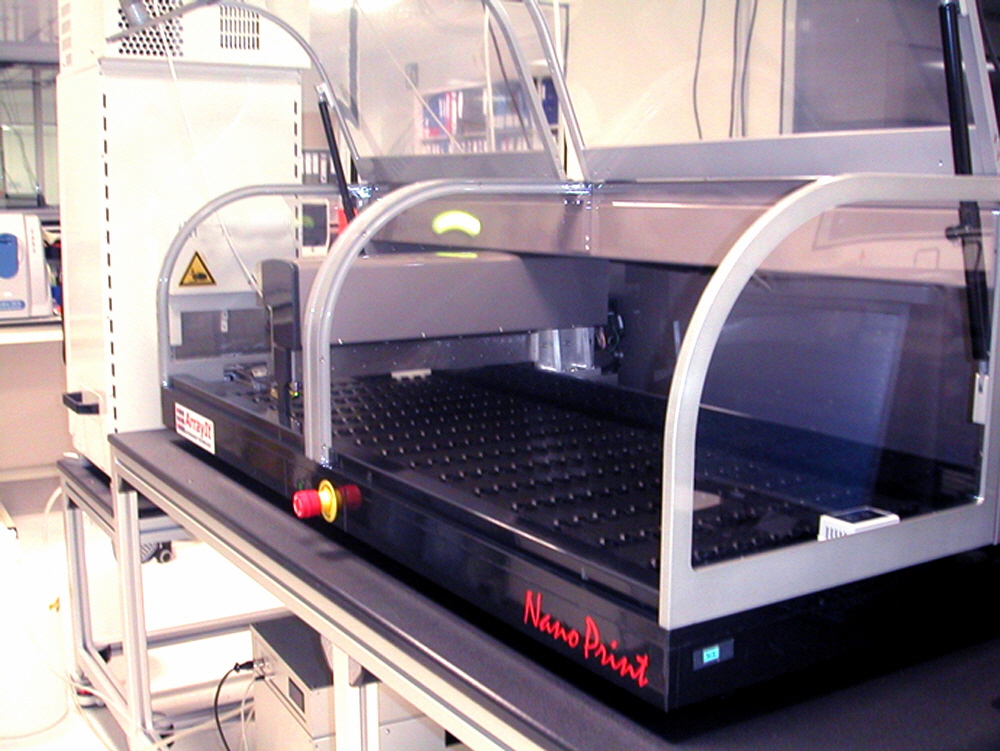
Figure 10. NanoPrint LM210 Microarrayer with 42-Plate Stacker installed in a cold room for specialized protein microarray manufacturing applications. Photograph provided courtesy of Johns Hopkins University, Baltimore, MD.
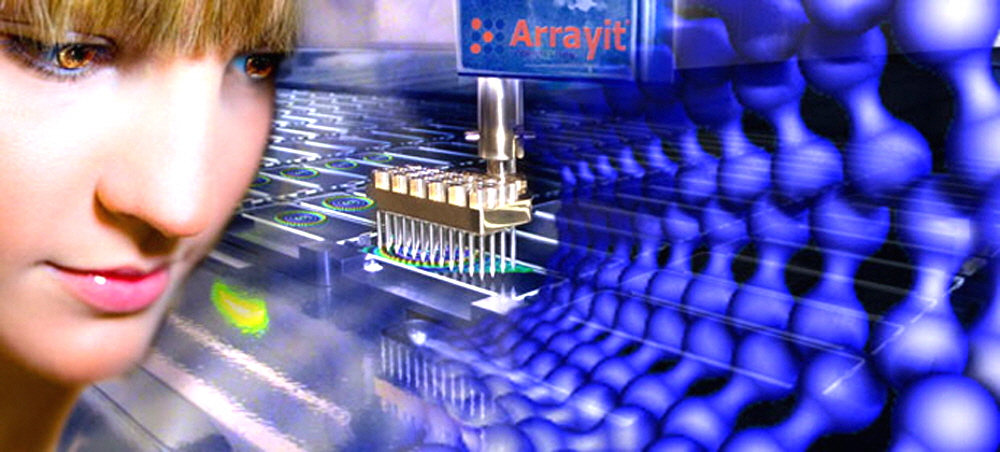
Figure 11. Arrayit NanoPrint™ 2 LM60PRO-2 and LM210PRO-2 Enterprise Level Protein Edition Microarray Printers move in nanometer increments and delivery nanoliter droplet sizes to empower a range of nanotechnology applications.
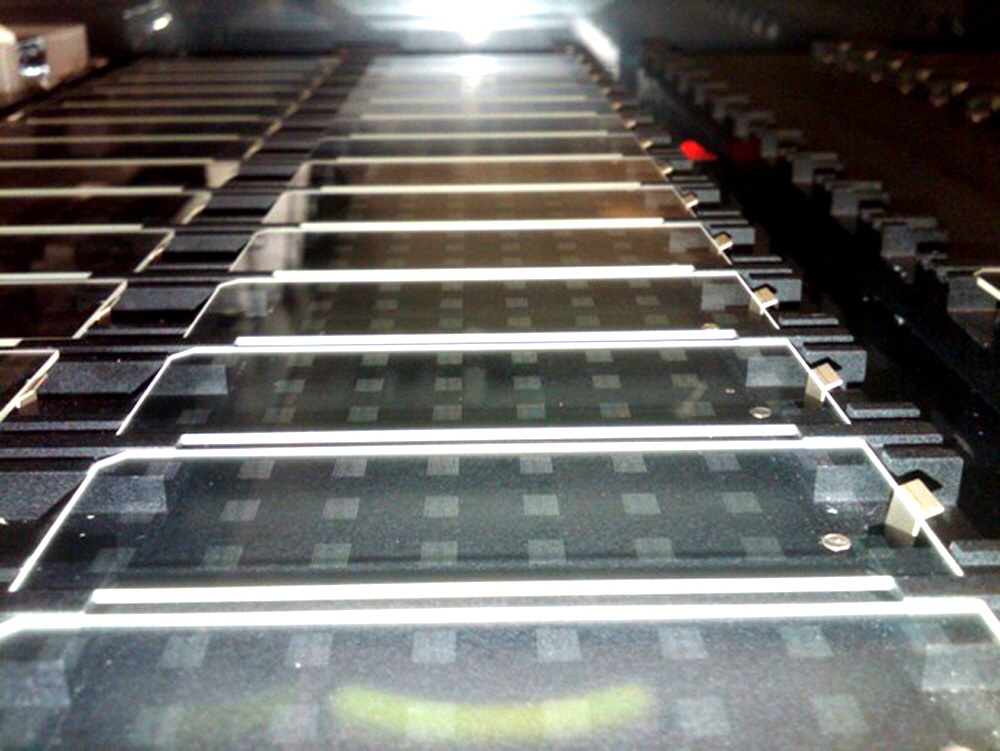
Figure 12. Arrayit NanoPrint™ LM60PRO-2 and LM210PRO-2 Enterprise Level Protein Edition Microarray Printers empower multiplexed microarray formats including 24 antibody microarrays per slide (shown).

